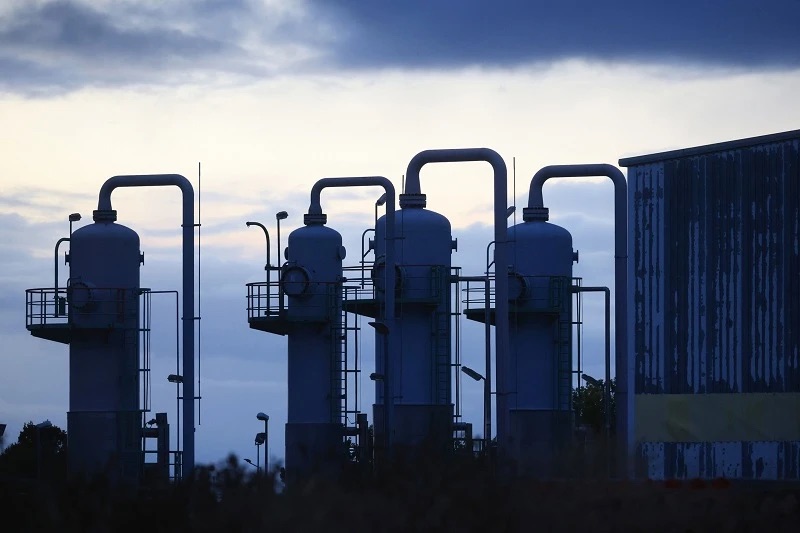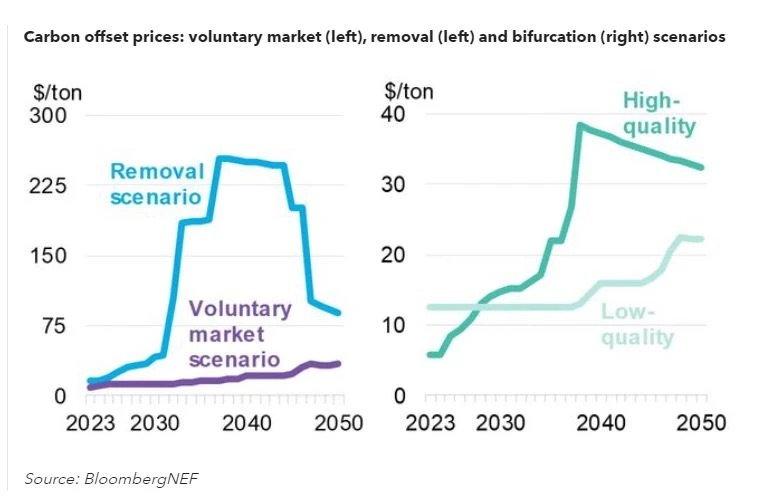Long-Term Carbon Offsets Outlook 2023
Published 08-01-23
Submitted by Bloomberg

Originally published on bloomberg.com
A turbulent year hasn’t thrown off the long-term prospects for the carbon offset market, which could be valued at half a trillion dollars annually by 2050. Demand will rise into the billions of tons of carbon dioxide equivalent within the next decade as companies work toward net-zero goals. Supply could increase nearly 60-fold depending on how carbon removal and nature-based solutions scale. If all offset types are allowed, the market will be oversupplied and prices will average just $18/ton out to 2050. Conversely, a removal-only market would increase this average to a massive $127/ton. A third scenario could see the market splitting in two, keeping prices reasonable but failing to direct investment to technology-based removal and the most impactful avoidance projects.
Long-term carbon offsets outlook 2023
- Offset demand dropped in 2022: Corporations purchased and retired just 155 million carbon offsets in 2022, down from 161 million the previous year. The biggest driver was growing criticism of carbon offsets by investors and the media, tempering enthusiasm from buyers. Crypto companies, who bought over 18 million offsets on the Verra registry in 2021, were also forcibly removed from the market midway through the year for fears of catalyzing investment into low-quality projects, cutting out a big chunk of demand.
- Offset supply rose slightly in 2022: Projects in 77 countries issued 255 million carbon offsets, up just 2% from 251 million in 2021. Avoided deforestation (REDD+) supply dropped 32%; major projects in Peru, Indonesia and Kenya received heaps of criticism and issued no offsets in 2022, as customers were wary of the reputational risk that could come from buying such credits. Reforestation and agriculture supply both rose in 2022 but it wasn’t enough to counterbalance the drops seen elsewhere.
- Companies will still need billions of offsets long term: Today’s fluctuating demand is mostly classified as behavioral, meaning companies buy offset to differentiate products or satisfy customers. It’s more responsive to prices and criticism, and BloombergNEF expects behavioral demand to drop from 181MtCO2e in 2023 to zero in 2050. It will be replaced by fundamental demand as companies work toward net-zero goals, increasing to 1.1GtCO2e in 2030 and 5.4GtCO2e in 2050. This demand is less price elastic and takes over long term.
- Carbon offset supply will likely grow significantly: In a market that allows all offsets like those seen today, regardless of their sector and geography, supply will exceed 8GtCO2e by 2050. Over three quarters of this supply will come from nature-based avoided deforestation, reforestation and agriculture. Conversely, a market focused on removal would catalyze massive investment into technology like direct air capture (DAC) and bioenergy carbon capture and storage (BECCS) in later years, pushing supply to 9.8GtCO2e in 2050.
- This report forecasts carbon offset prices under three scenarios: The voluntary market scenario assumes nothing fundamentally changes about the offset market, with companies buying all types of offsets. The removal scenario assumes companies can only buy removal offsets to achieve net-zero goals. The bifurcation scenario has the market splitting in two, with a smaller market for expensive high-quality credits and a larger market for everything else.
- Prices would be criminally low in the voluntary market scenario: Supply would be almost four times greater than demand in 2030. Offsets will cost just $13/ton at that point, valuing the market at a mere $15 billion. Prices rise to $35/ton in 2050, which is less than our previous outlook of $47/ton. This would be a disastrous outcome for the market – companies would continue to invest in cheap, low-quality offsets while sectors like DAC would fail to get needed investment. Issues thought to be largely tangential to the offset market today, such as the Russia-Ukraine War, the Brazil elections and compliance offset demand, could tighten the supply-demand balance and lead to much-needed rises in offset prices in this scenario.
- A bifurcation scenario lives and dies by the definition of quality: Once stakeholders create such a definition, it’s likely that the market diverges into a less liquid, more expensive market for high-quality offsets and a larger, cheaper market for everything else. BNEF estimates that such a market denoted by quality peaks at $38/ton in 2038, but would still be too cheap to incentivize investment into technology-based removal like DAC. A low-quality market would exacerbate many of the issues already seen in today’s market and prices would peak at just $22/ton in 2050. Just how fundamentally different these markets would be is based on how inclusive the definition of ‘high-quality’ is. This makes the work of the Integrity Council on Voluntary Carbon Markets and registries like Verra very important.
- A removal scenario would send offset prices to new highs, but the rise is gradual and gives buyers time to brace: An alternate outcome from the two scenarios above is a market that focuses entirely on carbon removals, which have inaccurately developed a reputation as always driving more impact than avoidance. This dichotomy is further obscured by groups like the Science Based Targets Initiative (SBTI), who will only allow members to achieve net-zero by using removal offsets such as reforestation, agriculture, DAC and BECCS. A removal-only market keeps the supply-demand balance skintight out to 2050, with the market briefly undersupplied from 2037 to 2044. Prices would rise to a manageable $42/ton in 2030, before shooting up to $105/ton in 2032 and $254/ton in 2037 – set by expensive forestry projects in Malaysia and valuing the market at $953 billion annually. Companies will have trouble stomaching such prices, but they come late enough that affordable alternatives may be available to still drive needed decarbonization. It’s also possible that a removal-only market could alienate buyers and lead to the creation of a separate pure avoidance market. In this avoidance market, offsets like REDD+, clean energy and clean cookstoves would be cheaper early on, but prices eventually reach $32/ton in 2050, valuing the market at $100 billion.

BloombergNEF (BNEF), Bloomberg’s primary research service, covers clean energy, advanced transport, digital industry, innovative materials and commodities. BNEF helps corporate strategy, finance and policy professionals navigate change and generate opportunities. Explore more content on the BNEF blog.

Bloomberg
Bloomberg
Bloomberg delivers business and markets news, data, analysis, and video to the world, featuring stories from Businessweek and Bloomberg News.
More from Bloomberg

